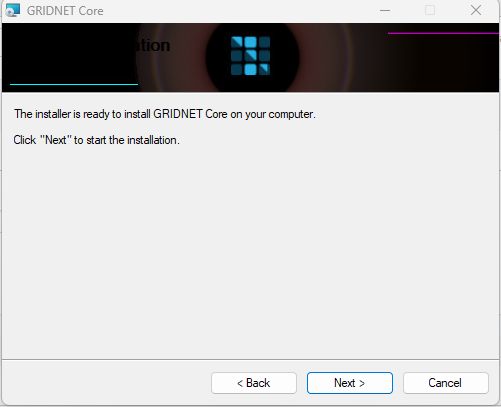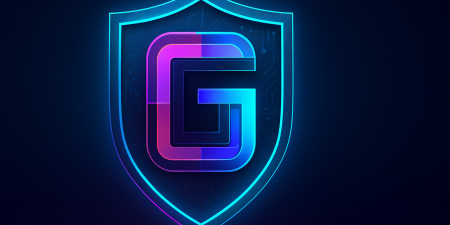
Welcome! Okay, so you’ve already decided on or are still considering becoming an Operator! Or maybe you are just about to discover what ⋮⋮⋮ is. Discovering it certainly is a journey.
In any case, good for you. Good for the ⋮⋮⋮ Community and perhaps good for humanity. The more of us,- the stronger we become! Who are ‘we’ ? People who became tired of the loosely defined ‘centralized crap’ attempted to be administered down our throats through centralized services and media.
We believe that information wants to be free. We believe in decentralized organizations. We believe in open markets. We believe in anonymity. We believe we know what we do, we believe we know what is good for us, we believe we are perfectly fine on our own. We read what we want and we watch and share what we wish. We believe in progress instead of regression, we write code which promotes recent research and efficiency instead of remaining stuck in 2010 with technology just like Bitcoin did – creating a religion with ‘evangelists’ running all around hoping for profits. We focus on good proper, useful tech instead. If you identify yourself with these statements – you might find ⋮⋮⋮ Community to be the right place for you.

We are people who perfectly do understand that thanks to advancements in science and technology we can now come up with with way ‘better’ means of providing value exchange,- but also services of any sort, ones possibly spanning across physical environments as well. The more decentralization, the more freedom is all around. We neither need banks nor ‘Good Pappas’ overlooking our shoulders.
And you are free to disagree, which is what freedom is about.

Operators – the Guardians of Freedom
The aim of this article is to serve as an introductory for individuals interested in becoming Operators. It provides some preliminary materials, every Operator should be aware of. As we go along, the article will take you step by step through setting up a ⋮⋮⋮ Node of your own. By reading through this very article, and by looking to the supplementary materials (such as research papers) you will get a solid overview of what is going on under the hood and equip yourself with utilities which could be used to assess your node’s state and to introduce changes, if and as needed in the future.
Should you wish to dive into the technicalities involved, so to better understand the differences between GRIDNET OS and previous technologies such as Ethereum or Bitcoin,- feel invited to read through our recent peer-reviewed Research Paper made available open access over here. Should any part of it be unclear or grab your interest in particular,- GRIDNET Talk (https://talk.gridnet.org/) is the right place to discuss. Ideas, thoughts? Feel invited to share! We are passionate about what we do and we certainly would greet other passionate fellas with welcoming hands. There are lots of crazy (cool) ideas, such as enabling for solar-powered crypto-incentivized routers in the midst of rural Africa, feel invited to bring ideas of your own along.. most of what we do has scientific, peer reviewed research to back it up, either pending or already published.
Did you know? There are now well over 50TB of ⋮⋮⋮ LIVE-programming sessions stored on YouTube, made available almost each and every day since the early 2017. Today most likely included. Everything to become open-source soon.
Operators maintain the ⋮⋮⋮ Eco-System. As an Operator, you will be responsible; – for maintaining the network operational and in good standing. On the other hand – there are benefits involved as well, – it is an opportunity for you to profit, through the system-intrinsic cryptocurrency, as yet again- everything was designed to be incentive compatible indeed. The Proof-of-Work difficulty is now rather low, so the sooner you jump aboard the better. The higher chances of winning the Proof-of-Work race. In fact, as of now, you might be ‘profitable’ with a either a low-end GPUs or even CPU. As an Operator, you will get to vote, you will get to choose. While neither you, nor any of us, has control over the entire network, – which we presume as desirable (as the system was designed to offer an alternative to centralized, possibly invigilated services in the first place, and thus opening the doors up to making the latter obsolete indeed) – there is still a plethora of management and customization options available – for nodes that you own.
🎶Music Proposal as you read along: https://www.youtube.com/watch?v=QIcLAHUeQX4
It is in your hands- as a highly respected Operator, together with other Operators- to help the eco-system thrive and to remain Operational. You decide on what basis and to what extent your node(s) are to participate within the ⋮⋮⋮ Eco-System. From the perspective of governance – true decentralization. Nothing more and nothing less. Somewhere around the globe there are people who need your help. They need access to information, they need to get things done, they need to let the others know. Without worrying about CEOs of centralized social platforms eliminating their posts or thinking whether some powerful ‘Good Pappas’ bring them into silence, after getting to know who they are (..) for whatever the reason. Nobody forces anyone to participate within the ⋮⋮⋮ Eco-System – it is a choice. It is a privilege. It is an opportunity. For open-minded, bright people, at least.
As the Old Wizard🧙 once said: “(..) It is a war even though there are no bullets flying by (..) – there are bits and bytes instead (..)
(..) The Old Wizard himself (..)
Now, if you are worried about ‘inappropriate contents’ being advertised publicly, worry not as we provide mechanics, allowing for these to be assessed by the majority. We certainly shalt not presume the majority to be composed of psychopaths. Do not let others bring your dreams of freedom and decentralization down by relating to adverse scenarios. As it already is, in the today’s world we are already well aware of individuals who gladly do exercise their excessive powers, be it for pure satisfaction, profit or due to other subjective reasoning. We want no CEOs. No governmental centralized institutions poking their fingers within. We do not need any of that. We are to allow for hierarchical, yet decentralized organizations to form. We, the ⋮⋮⋮ Operators, together – are to ensure that nobody, ever, ends up holding excessive powers in their hands. At the bottom of everything, we are thus to lay the underlying security,- in terms of the history of states of the ⋮⋮⋮ Decentralized State Machine, on the shoulders of the laws of physics. These should be rather strong, and invariant to either politics or financial affections, wouldn’t you agree? So to protect the community against internal and external distractions.
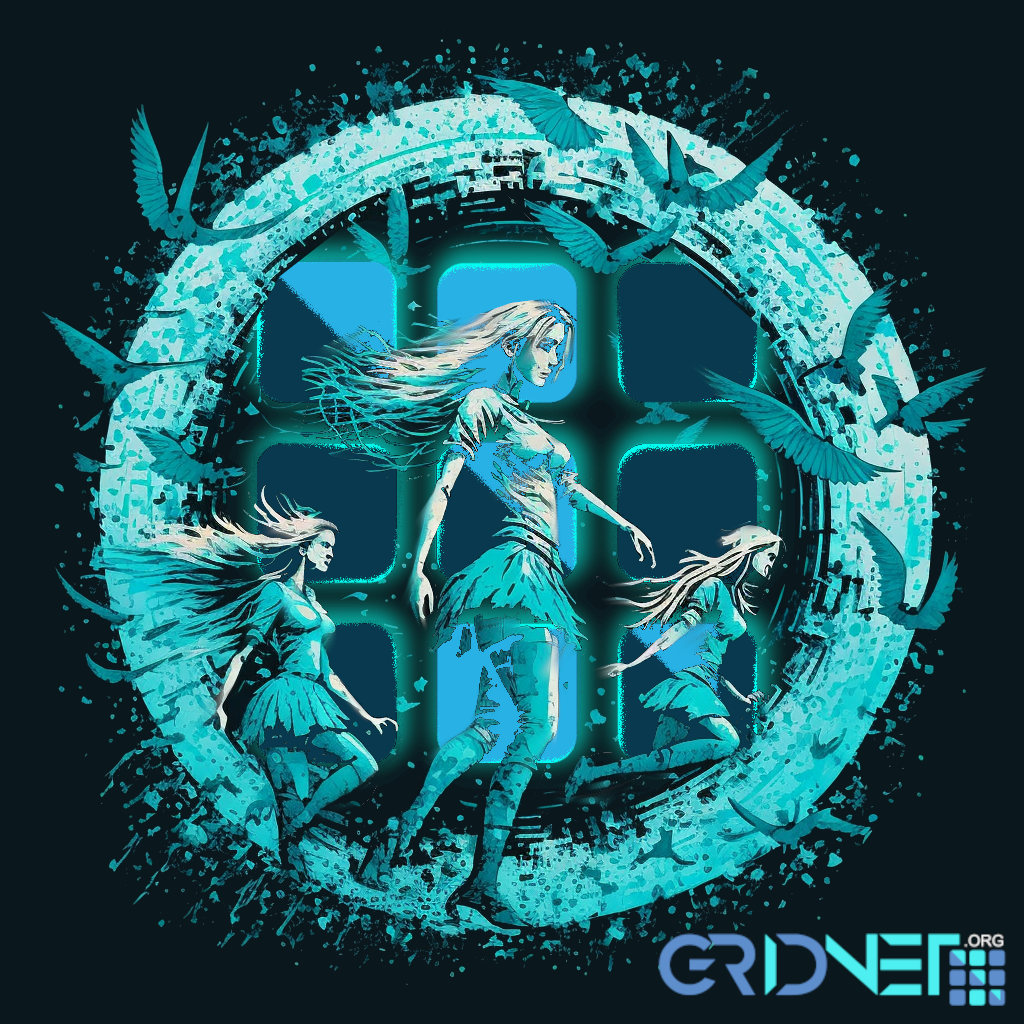
Now, Rejoice! As the time has come (..) for us to become truly free (..)
Choose Your Path
From the high-level, technical perspective, your choices boil down to deciding which ⋮⋮⋮ Sub-Systems you wish to have enabled (ex. decentralized storage, web anonymization services, maybe?).
Going further along these lines, you might wish to help process transactions broadcasted throughout the ⋮⋮⋮ Network, by enabling the appropriate corresponding ⋮⋮⋮ Sub-System. Then, you might choose to host assets of ⋮⋮⋮ Graphical Decentralized Applications (UI dApps in short – which might include games, business apps, social apps or whatever ⋮⋮⋮ Developers find fascinating to offer). You might choose to offer CPUs which would accommodate ⋮⋮⋮ Decentralized Processing Threads required by the former (..) you might choose to host ⋮⋮⋮ Decentralized Websites! (..) how about helping others around the world in getting anonymous, un-obstructed (ex. by governmental firewalls) access to the World-Wide-Web? ⋮⋮⋮ GRIDNET Core software embodiments the first-of-its-kind decentralized crypto-intenvitized web-proxy service!
Did you know? Wizards🧙 were the first to come up with the very first, scientifically proven, Sybil-proof data-exchange apparatus for computer networks of arbitrary topology. You may find out more in a yet another peer-reviewed research paper published by Springer Nature available right over here.
There is more (..) you might choose to host either encrypted or plain-text data files of others as they drag and drop these from their native operating system onto the ⋮⋮⋮ File Manager UI dApp (..) Fleeing hungry for experiments ? How about allowing for crypto-incentivized, solar powered wireless mesh networks? Join the forums and simply let these be..
If you are interested in involvement of ⋮⋮⋮ in various kinds of scenarios, including physical environments – the following peer-reviewed research, published by Future Generation Computer Systems – might be of particular interest to you: https://www.sciencedirect.com/science/article/abs/pii/S0167739X18307520
Having a choice enables for customization. Customization enables for optimization. We may have nodes dedicated to a single task – such as empowering decentralized, anonymized data-exchange or storage. Other Operators might focus on having their nodes do some heavy lifting by bringing their powerful GPUs into the ⋮⋮⋮ System.
While some of this might sound complicated, or even overwhelming, in terms of all the possibilities and choices.. as far as configuration goes, if you choose to enable all of the sub-systems (which is by default, which might turn out to be most profitable on a typical hardware) – all it takes to deploy a fully operational ⋮⋮⋮ Node (and for you to profit) – is to launch an automated installer catered for Microsoft Windows, launch the ⋮⋮⋮ app and to let it be. Your GPUs would be auto-configured, network configuration detected and configured autonomously as well, same goes for your private key and so on.. then keep your eyes and ears open for updates. We wouldn’t be introducing global auto-update mechanics, as that would be opening the system up to abuse and centralization even if it were for Wizards themselves.
Now, how about getting ourselves excited even more? Why don’t we take a look at a 3-minute video-clip showcasing the possibilities as seen from the end-user’s perspective?
(..) in here the sky certainly is not the limit , what you say?
The possibilities are to become even more striking as we are to proceed further with deployment of YouTube and Twitter-like decentralized social platforms and upcoming decentralized multiplayer games, trading platforms (..) all running as ⋮⋮⋮ Decentralized UI dApps (..) delivered the way they should be delivered indeed!

As an ⋮⋮⋮ Operator – you get to vote and you get to choose.
Getting Access
How do you interact with GRIDNET OS? ⋮⋮⋮ OS – the very first decentralized operating system – it provides Unix/Linux -compatible management Utilities and APIs. Made available to you, the Operator, through the ⋮⋮⋮ Terminal.
⋮⋮⋮ Terminal is available from:
- locally, meaning straight from the app ( use CTRL+W, CTRL+E keys to switch views)
- any node makes ⋮⋮⋮ Terminal available over SSH (port 22) – all it takes to commit actions is to scan a single QR code
- ⋮⋮⋮ Terminal UI dApp – available from the ⋮⋮⋮ Decentralized User Interface, accessible from web-browsers.
That’s from the Operator’s perspective. End-users might interact with GRIDNET OS through a plethora of other means, which include:
- surfing the World Wide Web Anonymously ex:
- https://test.gridnet.org:444/https://wikipedia.org – for anonymous Wikipedia
- https://test.gridnet.org:444/https://google.com – for anonymous Google
- ⋮⋮⋮ Dementalized Graphical Applications
- ⋮⋮⋮ GRIDNEToken mobile app alone (ex. crypto transfers)
- external code that takes use of the ⋮⋮⋮ Decentralized State-Machine
While #GridScript commands are available to developers of UI dApps, it is you – the Operator, who gets to execute some of the commands with local, administrative privileges. This might be needed for configuration. From time to time, you might also want to jump straight into action and ban individuals attacking your ⋮⋮⋮ Node. Worry not, as the autonomous ⋮⋮⋮ Firewall services embedded into the software are to remain operational at all times, yet still.. in terms of your nodes,- you’ve got the power.
Whatever path you choose, for everything you shall be rewarded (storage, data-exchange – on per-byte basis, processing fees, etc.). The network ensures rewards for some of the most miniscule activ9ities, such as block-exchange and transactions’ retransmissions to other nodes. That is thus in your sole incentive to configure routing of ports on NAT/ router properly, as otherwise, others wouldn’t be able to connect with you, implying less income, implying lost opportunities. Even if you choose to operate ⋮⋮⋮ Node for altruistic reasons, do accumulate the assets. You might want to put these into good use later on..
If you are feeling technical, do know that GRIDNET OS is an extremely active research project. Yet again, we strongly encourage you to read this Research in particular to get a better overall understanding of the technology,- you as a highly respected ⋮⋮⋮Operator, now help to increase the proliferation of..
Laboratories
If you ever wonder how we test our software, you might be interested in taking at glimpse at one of our laboratories:
Let’s Get Started
The recent version of GRIDNET Core installer is always available at https://gridnet.org/GRIDNETCore.zip
Release Notes are published at GRIDNET Talk.
First, download the Installer, it would take you by hand through everything
Once the installation is complete and you get to launch the software.

In [1], there’s the location of the log-file. All the events appearing in the Events’ View also make their way into this very file.
Little below, there’s a path where all the data files are to be stored at.
In [2] should a need arise, you may choose to wipe out all the data files (including your Operator’s private key). Note: the Operator’s private key is generated autonomously during the bootstrap process. You may then choose to export your private key to the mobile app, through a QR code which would be rendered within the Terminal. More on that later.
If you ever decide to do so, you would be shown with a screen reassembling the one below:

GRIDNET Core was designed to configure itself autonomously without your aid. That is, if you do not decide to disrupt and override the automatic configuration process.
Thus, right after the initial auto-destruction inquiry, you are asked whether to proceed with autonomous configuration:

If you do not confirm within a few seconds, the system would proceed automatically.
Now, during consecutive launches of the software, at this stage, you would see a screen looking like the one below:
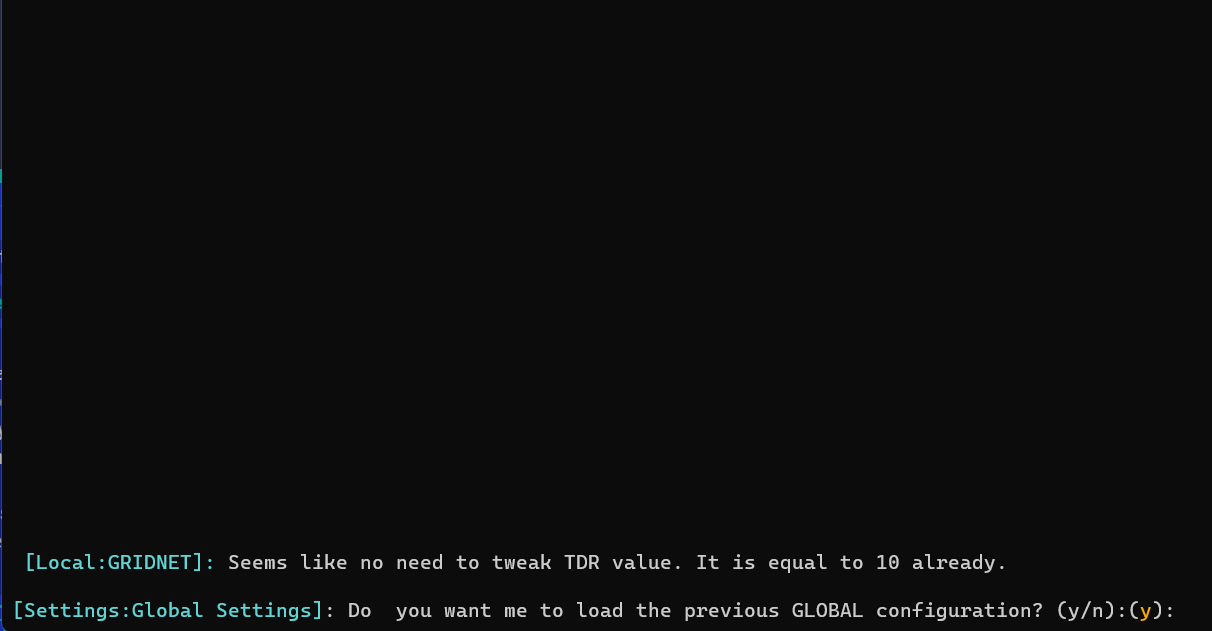
Reportedly, the TDR value must had been already previously tweaked, and the system is about to proceed with previous configuration.
Now, the system attempts to deploy the internal data-store for all modes of the network (Test-Net, LIVE-Net etc.) No need to worry about any of that.

In a few seconds, one would see the above question. If you do not object (by pressing ‘N’) the system would continue loading the previously established configuration.
During the autonomous configuration process, you would be seeing lots of events rushing through:

Yet again, nothing to worry about, unless something unexpected happens and/or the system needs your assistance in which case you would be asked to assist and/or to decide upon some things.

Soon enough Windows Firewall would display a pop-up asking whether you agree for GRIDNET Core to be utilizing your network connectivity.

Since Internet connectivity is required, simply tap on allow access.
By default, when autonomous self-configuration enabled, during the bootstrap sequence, the system attempts to initialize all of the following sub-systems:
Notice: recently lots of effort has been put to enable for all the below sub-systems to be multi-plexed over just a single port (443 TCP/UDP) – so to improve resilience against mis-configured firewalls and/or NATs. You may read more about it in Release Notes of version 1.0.3 here.
⋮⋮⋮ Sub-Systems
- Blockchain Manager – the main subsystem for each of the sub-nets (Test-Net, Live-Net etc.)
- Transaction Manager -responsible for processing of any processable objects. That includes Data Blocks, Transactions etc. Works closely with its corresponding Blockchain Manager.
- Network Manager – the main networking sub-system, other networking sub-systems derive from and are controlled by. These other networking sub0systems include:
- Internal Web-Server – provides access to the Decentralized User Interface to clients over web-browsers. It also serves files from the Decentralized Storage, should one decide to access these directly (ex. for NFTs). This service employs ports 80 and 443 for encrypted TLS 1.3 based communication.
- Decentralized State Machine (DSM) Synchronization service – takes care of facilitating data exchange required by the decentralized consensus (scheduling of block downloads, broadcasting of transactions etc.) That sub-system is in close cooperation with the corresponding Blockchain Manager.
- Decentralized Storage – just as the its name suggests. That includes full-redundancy ‘on-the-chain’ storage and off-the-chain storage through a crypto-incentivized variance of Torrent protocol. At the bottom of everything the system employs RocksDB as a data-storage engine.
- UDT communication Core Service – data-center class data-exchange protocol, way more efficient than TCP.
- Web-Socket Communication Sub-system – employed mainly by the decentralized user interface.
- WebRTC Communication Core Service – used by UI dApps employing decentralized cross-browser communication. Thanks to your node providing this service, these UI dApps do not need centralized servers, even for what is called WebRTC signaling.
- SSH-based Terminal Core Services -for spawning command-line based user interface to clients connecting over SSH. Employs TCP port 22.
- Decentralized Web Anonymization Service – from the Operator’s perspective, you earn Coins by helping others browse the Internet anonymously. Others may choose to access your services directly (ex. by visiting https://[YOUR_PUBLIC_IP]:444/https://wikipedia.org). As your node bootstraps feel free to take these services offered to others for a spin yourself simply by visiting https://localhost:444/https://wikipedia.org. Surprise you are now Wikipedia!.. Go ahead try with Google as well https://localhost:444/https://google.com. Wooohooo.. your node now is Google. This decentralized service is also available to creators of UI dApps. The most notable UI dApp which already employs this service is the Browser UI dApp. It not only provides additional layers of anonymity but allows for persistent customization of the looks of external websites. Remember that there are countries in the world that prevent citizens from accessing services such as Wikipedia and/or Google.
- Peers’ Discovery Core Service – allows your node to discover others in a fully decentralized fashion. There are a couple of bootstrap IPs encoded into the software; you may provide additional IPs during the Bootstrap sequence. Under the hood, the system employs a variance of Kademlia protocol.
- Work Manager – quite a sophisticated computational engine. For now, it is mostly used as an abstraction layer over the underlying OpenCL sub-system, for computing ‘Proof-of-Work’. Yet still, the system is much more capable. Once it bootstraps it attempts to detect all your CPUs and GPUs. By default it would prefer dedicated GPUs over integrated GPUs and/or CPUs. You may change these settings by overriding the default bootstrap sequence. One of the more interesting aspects is its ability to deploy virtual GPUs, beta-support of verifiable computations, computational tasks that can be advertised throughout the network and other things. Should this sub-system fail to initialize mining services would **not** be Operational. Ensure to keep your GPU drivers updated at all times.
- Internal Firewall – autonomous firewall service. Should anyone attempt to abuse any of the above mentioned services in any way. He or she would be banned. It’s as simple as that. No action on your part is ever required. Pretty cool, huh?
Now, getting little bit ahead of us – after all the initial bootstrap sequences are completed, your node would enter a Grace Period. The period may last anywhere between 5-20 minutes based on the detected performance of your hardware and/or network connectivity. That’s the time your node is given to sort out any pending matters such as performing network synchronization, updating files behind the decentralized user interface etc. After that period is over, the Work Manager would be armed by Blockchain Manager and become ready for Proof-of-Work operations. But for one thing. In order to be energy efficient, the system would not proceed with these operations unless it finds to have rational chances of winning the proof of work race. That usually means your node synchronization state being > 97% and not too far off the Horizon of Events. Now, that sounds sort of Epic does it not.
Only once the Work Manager is armed, and only once Blockchain Manager deems to have non-negligible chance of winning the proof-of-work race, would it decide to compile the OpenCL Kernel, the fans would begin spinning (..) they would (..) and the money would begin flowing in (..).
OpenCL Kernel is a low-level program written in pure C, that carries our the proof-of-work algorithm. We have introduced some optimizations to the process. Why? Compilation of the Kernel is device-specific. If you’ve got multiple GPUs, each such GPU needs to have the OpenCL compiled for it specifically. Now, the bummer is the process may take hours. So, we’ve introduced some optimizations to mitigate and offset for such a technical drawback. So, once the kernel is compiled for each computational device, the resulting binary code is cached both in RAM and the binary code is stored onto the hard-drive. So in short, if you see the kernel taking long to compile… let it run. Next time you launch the software the pre-compiled binary would be fetched from hard-drive in less than a second and each of your GPUs would initialize almost instantly.
Now, let us go back to the Events’ View.
Note: you may switch between the Event’s View and Operators Command Central at any time by using key combinations of [CTRL+W] and [CTRL+E] respectively. The Global Chat view is not available from Core directly, one would need to SSH over to local node and press [CTRL+Q] over SSH to be able to chat with the others.
As the sub-systems are initialized, you would be informed on the progress of each initialization of each of these, ex. :

Before the system agrees to fully initialize and become Operational, it needs to perform integrity validations of all of the data stored locally. Above everything this includes validation of the local Verified Chain Proof. The concept of a chain-proof is sort of complicated and would be described in detail another time. For now, let it suffice to say that it is a sequence of block-headers comprising the verified history of events (built of data-blocks). As soon as nodes connect with each other, they let the other peer know about the latest block they are aware of. The other peer looks at the provided block-header and if it finds the block to be of interest, it queries the sender for a chain-proof, at the same time providing few reference points, from the history of events, the chain-proof could begin at. Such points typically correspond to blocks in the past the node already became aware of and verified. It provides such reference points during chain-proof inquiries so to minimize network overheads. Otherwise nodes would either be exchanging entire chain-proofs – starting at the very first genesis block, up to the most recent block-header.
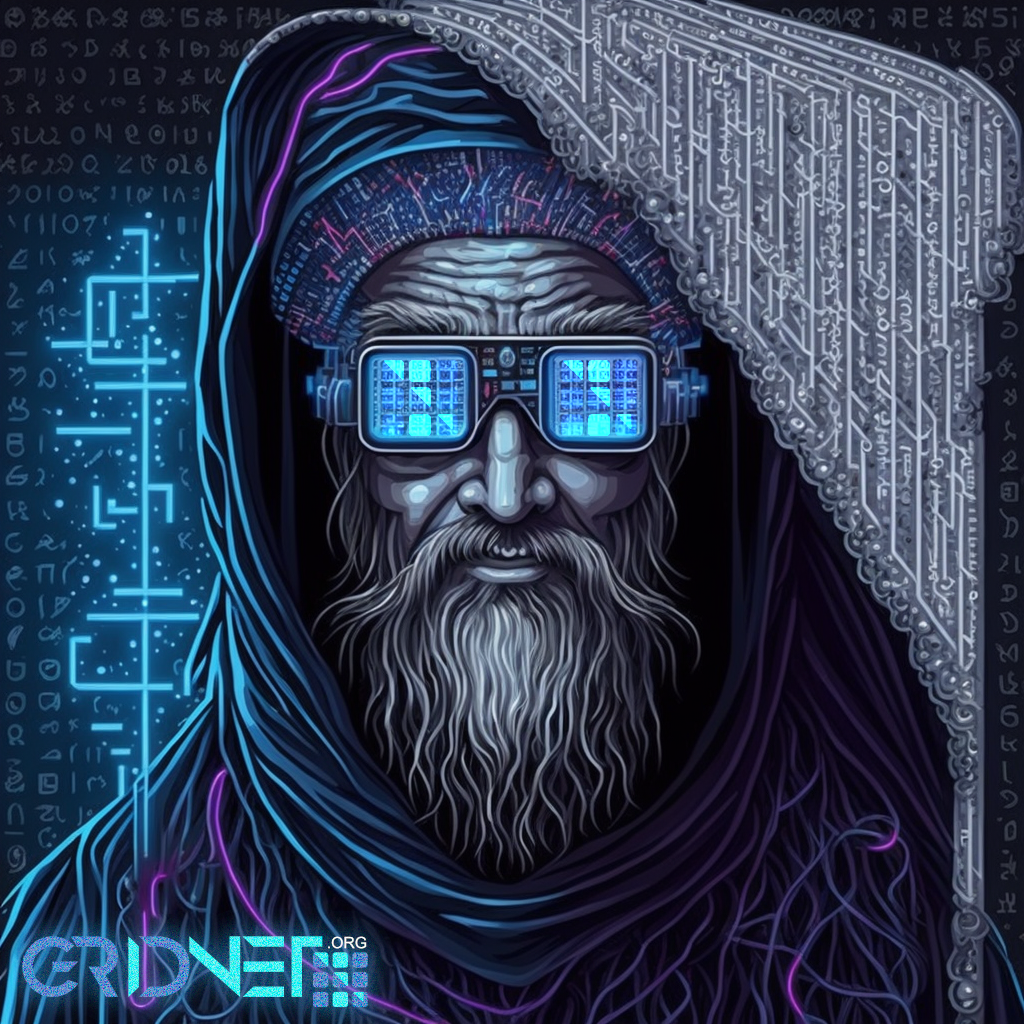
Wizards keep paving the paths of Decentralization (..) for the all of us (..)
Operator, the gist is, that before your node attempts to download any data, it needs to be ensured that the data truly does become part of the global history of events. Chain proofs allow for the very that, before the data is even downloaded. How is it even possible? Remember, a chain-proof is comprised of a sequence of block headers. Headers of both data-blocks and key-blocks. Even though block-headers do not contain any actual payload (transactions, files, NFTs etc.) they contain representations of Proof-of-Work – in the case of Key-Blocks and a signature of the issuer– in the case of data-blocks. Of equal importance – both types of blocks encapsulate a reference to a previous block. Thus, even without seeing the actual payload and just by looking at the chain-proof, the node can decide whether the given history of events is secured by proof-of-work, and whether to schedule the actual blocks, with payload (transactions, NFTs etc.) for download. It can calculate the total cumulative proof-of-work of the entire history of events, represented by the given chain-proof. An interesting point is, that as partial chain-proof are delivered, they can still be used by the receiving node to reconstruct a full-chain proof, if it starts with one of the check-points provided by the other peer during the inquiry. Operator, keep in mind that chain-proofs are exchanged reactively. These are requested only in the event of having previously received a block-header which was found to be of interest. Nodes distribute block headers describing most recent blocks (block-leaders), to all connected peers, as soon as these change.
Operator. The software keeps track of two chain-proofs. The Heaviest Chain Proof and the Verified Chain Proof. The earlier represents the heaviest, in terms of both the cumulative Proof-of-Work and length (to account for both the data-blocks and key-blocks) history of events. It is modified only based on the received chain-proofs. It can be said that the heaviest chain-proof serves mostly the purpose of scheduling blocks for download.
The latter, it represents the history of events **that was verified by the software, locally. ** It is the most crucial and protected data-structure. It can be modified only during a Flow on a per-block basis (full processing a of block including its payload i.e. transactions). When nodes are queried for chain-proofs they respond only based on this verified chain-proof, not the heaviest chain-proof.
Notice that as blocks from the Heaviest chain-proof are downloaded and verified, the heaviest chain-proof steadily becomes the verified chain-proof, as long as blocks pass full verification.
That double buffering mechanism is of a paramount importance. It ensures that invalid blocks not having a chance of extending the history of events are not downloaded, protecting your software against a broad family of attacks. Just imagine an evil node trying to waste your node’s computational power by providing it with data blocks containing invalid processable objects. Such data-blocks, containing invalid transactions would need to be both downloaded and then processed by your node’s CPU. Second, the headers of blocks comprising the Heaviest Chain-Proof are used as a data-source for the Network Manager which schedules consecutive data-blocks for download. Network Manager does so by generating appropriate Network Tasks which are distributed among peers – your node managed to establish DSM-synchronization enabled connections with (ex. connections with mobile devices, web browsers etc. would not count as such). Download tasks are distributed in accordance to a random distribution.
Enough theory. Let us go back to the interface of GRIDNET Core:

Lots of events flowing by.
[3] – a data-block received by the node managed to make its way into the Verified History of Events. It extended the blockchain.
[4] – each state of the Decentralized State-Machine has its identifier. We call it a Perspective. You may switch to any locally available perspective command by using the ‘perspective’ command from the Operators console and providing the identifier as an argument. Recall that one may use ‘sync’ to synchronize one’s Terminal with the current state of the DSM. In SSH sessions it is not needed but when accessing Terminal services directly from the Operator’s Pane, one needs to execute ‘sct test net’ first. SCT stands for Set Commit Target.
[5] – our concept of processing of received data shares some similarities with what is known from the realm of Database Systems. Instead with ‘transactions’ though, we deal with ‘flows’. The concepts are similar though. Each data-block is processed within of a ‘flow’. Processing of a flow, if successful, results in a new Perspective. Each data-block encapsulates its identifier.
[6] – Status Pane – refreshed in real-time. While the log may be little bit behind, this line is always 99.9% accurate. It comes with a couple of indicators. Some of which are there all the time, others seldomly appear ex. during an update. The static ones include:
[BH] – current height of the blockchain.
[Sync] – current synchronization state
[BQ] – blocks pending processing by the Blockchain Manager
[Vitals] – an attempt of the software to notify you, the Operator, and others that connect with your node about its current status. Notice that the very same Events View is available to anyone who connects through SSH.
Now, how about getting a glimpse of Operator functionalities?
Press [CTRL+E] to enter the Operator’s Command View.
Type ‘ifconfig’ to see the Virtual Network interfaces that were auto-configured during the initial bootstrap process. You would be presented with a view similar to the one below:

Should you wish to introduce any changes, you may get to know your options by appending ‘–help’ to the previous command as its invoked, just like shown below:

One of the things worthy to notice is the amount of bytes exchanged on both of the two auto-configured interfaces.
Eth0 represents the publicly available interface. The IP address assigned is used for instance within QR Intents generated by your node, as well as within the WebRTC protocol and throughout the Decentralized Web Anonymization services. Should you have multiple public IPs available you may to reassign as needed.
Eth0 represents the interface the node listens on for incoming connections. 0.0.0.0 represents any IPv4 address available. Should you wish to limit IPv4 addresses your node listens on, you may want to reassign it to a more specific value.
Operator, we’ve already mentioned the Internal Autonomous Firewall Service. How about taking a look at some of its current state? For this you may use the ‘firewall’ utility. The utility displays its internal man-page as soon as it is invoked:

Operator, should you decide any user to be auto-banned by mistake you can pardon the peer by using the ‘whitelist’ option. Should you detect any suspicious behavior by manually analyzing event logs? Ban the other peer at once.
At the beginning we’ve mentioned that during the initial bootstrap sequence, GRIDNET Core generates your Operator’s wallet all by itself. In fact, it generates a multi-dimensional wallet. What does it mean? The topic is rather complicated all in itself (..) let it suffice to say that as your node operates, it may dynamically generate new identities (by default up to 10) and use these for identification purposes. Joggling identities may be beneficial for increased anonymity. And yet still, all it takes is your main private key to recover assets from all of the offspring identities.
How about getting to know your Operator’s Master Private key? Have your mobile device with the GRIDNET Token mobile app ready at hand. The private key, alongside your entire Operator’s Key-Chain would make its way onto your mobile device so to rest there securely.
Switch to the Operator’s Command Pane, make sure you are not in the scope of any State Domain. Then:
- First, execute the ‘sct testnet’ command to make sure you are operating on the realm of the Test-Net.
- Second, execute the ‘getkey — help’ command to familiarize yourself with the ‘getkey’ utility.

- Once ready, and after having ensured that nobody is looking over at your screen, type ‘getkey’ alone. . In a moment a QR code would be shown:
- Scan the QR Intent with the GRIDNET Token mobile app.

That would be all for now. You might expect another fascinating article dedicated to the technicalities behind ⋮⋮⋮ Decentralized World Wide Web proxy service to be published soon, we’ll be also striving to continue documenting #GridScript commands and APIs.









